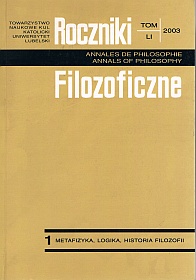John Searle: From speech Acts to the Social Reality
(transl. by Agnieszka Lekka-Kowalik i Zygmunt Pikulski)
Abstract
The paper presents an overview of the development of Searle's philosophical thinking, from Speech Acts to The Structure of Social Reality. It draws out the fundamental naturalism of Searle's approach and illustrates the philosophical methodology that is dictated thereby.
The work Speech Acts contains Searle's general theory of regulative and constitutive rules and of brute and institutional facts – all components which play a significant role in the development of Searle's thinking. According to Searle constitutive rules have the basic form: X counts as Y in context C. Speech acts are acts performed by uttering expressions in accordance with constitutive rules of just this type. When one performs a speech act the corresponding system of constitutive rules constitutes what Searle calls an institutional fact. Institutional facts are facts which exist because we are here to treat the world and each other in certain, special (cognitive) ways within certain special (institutional) contexts.
In his The Construction of Social Reality Searle utilizes this framework as the basis for a new type of theory of the huge invisible ontology of the social world. The crucial new element in this theory is the notion of collective intentionality. Like other higher mammals, human beings enjoy a certain sui generis capacity for engaging with others in cooperative behaviour in such a way as to share the special types of beliefs, desires and intentions involved in such behaviour. The history has shown that we are able to engage in ever more complex forms of collective intentionality of seemingly inexhaustible variety to perform collaborative actions. Language is conceived by Searle as the basic social institution because it is language or language-like systems of symbolization which enables these new forms of collective intentionality to exist.
Searle's ontology of social reality is formulated against the background of the naturalism: everything that exists is part of the natural world that is studied by physics, by biology, by neurology, and by psychology. This is true even of the edifice of institutional facts we call social reality. Money and drivers licenses are parts of the natural world, since they are all portions of physical reality upon which special properties have been bestowed by collective intentionality. But there is a problem with this theory: many parts of social reality are not also parts of physical reality. This applies to debts, relations of ownership, and to many financial instruments. It may also apply to corporations, universities, governments and other higher-order social objects. Searle's social ontology is then not compatible with Searle's naturalism, and the paper concludes with an investigation of the consequences of this incompatibility.
Copyright (c) 2003 Roczniki Filozoficzne

This work is licensed under a Creative Commons Attribution-NonCommercial-NoDerivatives 4.0 International License.





